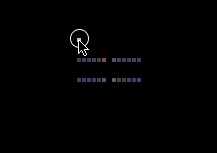Difference between revisions of "Complete Electronics Tutorial"
| Line 17: | Line 17: | ||
The most basic conductors are METL, PSCN, and NSCN, which are found in the electronics menu. These are what you will use most of the time to transfer electricity. METL conducts to both PSCN and NSCN, and both PSCN and NSCN conduct to metal, as demonstrated below. | The most basic conductors are METL, PSCN, and NSCN, which are found in the electronics menu. These are what you will use most of the time to transfer electricity. METL conducts to both PSCN and NSCN, and both PSCN and NSCN conduct to metal, as demonstrated below. | ||
| + | [[File:1-1-Conductors.gif]] | ||
| + | |||
| + | However, things get a bit complicated. While PSCN conducts to both METL and NSCN, NSCN cannot conduct to PSCN. | ||
| + | |||
| + | [[File:1-2-Silicon.gif]] | ||
| + | |||
| + | This behavior can be used to make a diode, which allows electricity to flow only one way. | ||
| + | |||
| + | [[File:1-3-Diode.gif]] | ||
===Using SWCH to Control Electronics=== | ===Using SWCH to Control Electronics=== | ||
Revision as of 21:19, 14 September 2015
This page is currently a work in progress.
Contents
Intro to Electronics
This section is primarily for new players, so if you already know about the basics of electricity, SWCH, WIFI, and INST, you can skip ahead to the next section.
Basics of Electricity in TPT
How SPRK Works
SPRK, found in the electronics menu, is the basis of all electronics in TPT. SPRK is an indestructible solid that cannot be placed, but it can be "drawn" on to metals and conductive elements. When a conductive element is sparked, it is replaced with SPRK and the ctype of the SPRK is set to that element. The life of the SPRK is set to 4 and when it reaches 0, the SPRK will replace itself with its ctype. SPRK will also transfer itself to any conductive elements within 2 pixels.
This allows SPRK to move along conductive elements, which include all metals, WATR and SLTW, MERC, and QRTZ (when under pressure).
Basic Conductors
The most basic conductors are METL, PSCN, and NSCN, which are found in the electronics menu. These are what you will use most of the time to transfer electricity. METL conducts to both PSCN and NSCN, and both PSCN and NSCN conduct to metal, as demonstrated below.
However, things get a bit complicated. While PSCN conducts to both METL and NSCN, NSCN cannot conduct to PSCN.
This behavior can be used to make a diode, which allows electricity to flow only one way.

